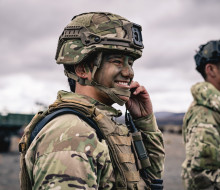
Keeping skills alive in transfer to Reserve Force
05 July 2024
Unfortunately you are viewing this website on an outdated browser which does not support the necessary features for us to provide an adequate experience. Please switch to a modern browser such as latest version of Google Chrome, Mozilla Firefox, Apple Safari or Microsoft Edge.
Ngā mihi nui
A Royal New Zealand Air Force (RNZAF) pilot who has served for more than three decades and trained hundreds of fellow pilots has been awarded the New Zealand Distinguished Service Decoration (DSD)
Squadron Leader Paul Stockley, who is an instructor at the RNZAF Base Ohakea Central Flying School, was awarded his DSD for services to the New Zealand Defence Force over 32 years.
“I am honoured and humbled by this. How could you not be,” he said.
He could only speculate on the reasons for the award – perhaps it was his cumulative flying time for the RNZAF (more than 7500 hours across 30 different types of aircraft) or the range of his appointments.
Throughout his career Squadron Leader Stockley has filled every key leadership position in the RNZAF flying training system and has also flown and instructed for the Royal Air Force (for four-and-a-half years) and Royal Australian Air Force.
Growing up in Lower Hutt, he enlisted in 1987, soon after leaving school and began pilot training.
“I always wanted to be a military pilot. There’s never been anything else on the radar.”
He qualified as flying instructor in 1996 and has flown with the Red Checkers aerobatic team flying the CT4 Airtrainer and led the RNZAF aerobatic team the Black Falcons with the T-6C Texan II.
He was a qualified pilot with the Air Force Heritage Flight, having flown the Second World War-era North American Harvard and Grumman Avenger.
Squadron Leader Stockley said he enjoyed the challenge of military flying.
“Every single flight is a challenge. To achieve the task we are asked to do with the aircraft is always a challenge. That’s the pure side of flying, but what I like are the operational tasks that we do as well.”
His favourite aircraft to fly on operations was the Iroquois helicopter, which he spent a number of years flying and instructing on, including two tours in East Timor, which included time as the helicopter detachment commander.
He was also proud of the many search and rescue missions and cyclone relief operations he was involved with and takes great pleasure in following the successes of the many pilots he has trained.
Throughout his career he was able to use the skills he was given through quality Air Force training to help others and considers it a privilege to now be a part of the same training system that continues to produce similar quality pilots, he said.
“To see someone that hasn’t had any flying training, or who hasn’t trained anyone before, to evolve into an Air Force pilot or Air Force instructor is extremely rewarding.”